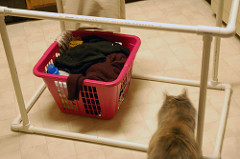For those of you who have been following the series, today’s post may seem like a contradiction to last week’s Do A Little, A Lot, but just go with it.
We’re going to start off with a brief physics lesson.
I draw your attention first to Newton’s First Law of Motion:
Inertia is the resistance of any physical object to a change in its state of motion or rest, or the tendency of an object to resist any change in its motion. (From Wikipedia).
What does this have to do with efficiency?
Well, let’s break this down into plain English first. An object at rest is going to stay at rest unless acted upon by some outside force. An object that’s in motion will stay in motion unless something acts on it from the outside to move it faster or slow it to a stop.
I hypothesize that the same is true of people.
This is why I try to finish all tasks completely when I attempt them rather than stopping in the middle. Sometimes this is easier than others. Some projects take longer. Sometimes you get interrupted. But if you follow through on a task from beginning to end, you’re in motion, and you’re going to stay that way until you finish–probably faster than you would if you stop and have to come back to it later.
Perfect illustration: Laundry.
Now laundry is a multi-step process. You have to sort into like colors. Wash it. Throw it in the dryer. Fold or hang it and put it away. (My husband doesn’t seem to grasp that this final step is actually a part of “doing the laundry”. He tends to skip this part when he does laundry.)
The first part of this lends itself very well to the Do A Little A Lot philosophy. There’s a lot of waiting in between these steps so you can transfer each load from one place to the other. But the last stage…getting the laundry out of the dryer and putting it away should be all one step.
Why?
How often do you pull a load out, take the hamper to the bedroom and then walk away to do something else, only to find that 4 days later, you still haven’t put the laundry away and it’s still in the hamper in the floor where your cats have decided to make a nest? Or maybe you’ve just been using the hamper as a dresser and have been pulling clean clothes from it to get dressed in the morning? Maybe you set the clean clothes on the bed so that you’ll be forced to put them away before you go to bed. I don’t know about you, but that doesn’t work well for me. It annoys me to delay bedtime and for hubby’s part, he’ll just take the clean clothes and put them in a pile to deal with later. Which usually leads to a variation of living out of the pile instead of actually putting them away.
This is inefficient and messy. By taking the laundry straight from the dryer to the bedroom and immediately putting it away, you’re getting it over with much faster (in 5-10 minutes) and there’s no chance for it to linger until you “feel like” putting it away again.
That’s really the crux of it. Often the tasks that suffer most from lack of follow through are the ones we don’t really want to do in the first place. They’re annoying, a pain in the butt, so we procrastinate. Instead, make it a policy to suck it up and follow through. Eat that frog, as Brian Tracy is apt to say. You’ll find yourself with more time on your hands because you did.


8 thoughts on “Efficiency 101: The Power of Follow Through”
I would like practical illustrations of the laws of thermodynamics please and thank you. Lol
Ha! I’ll see what I can do!
Those days when you wish you read something on Facebook!
Again, you’ve demonstrated my own philosophy on getting things done!
I am the Queen of Planning and Starting – but it all ends there. I wish I could follow through and actually finish things. This happens with my writing as well. Lots of stories started or still lingering in my head.
Jenna
Ahh, laundry on the bed, eh… Okay, I’ll try it properly tomorrow morning when I take tonight’s load out. Might have to set the alarm for 15 minutes earlier…
Procrastinator here as well. My method is slightly different than yours but still, things get done. As long as it works.
Amazing how you can see our laundry process, although I’m usually the first to put things away. Great analogy of inertia.